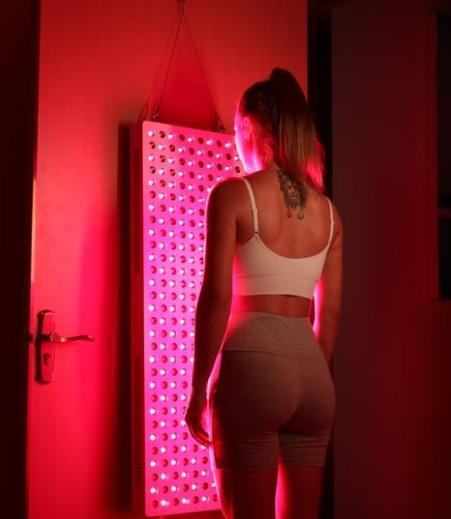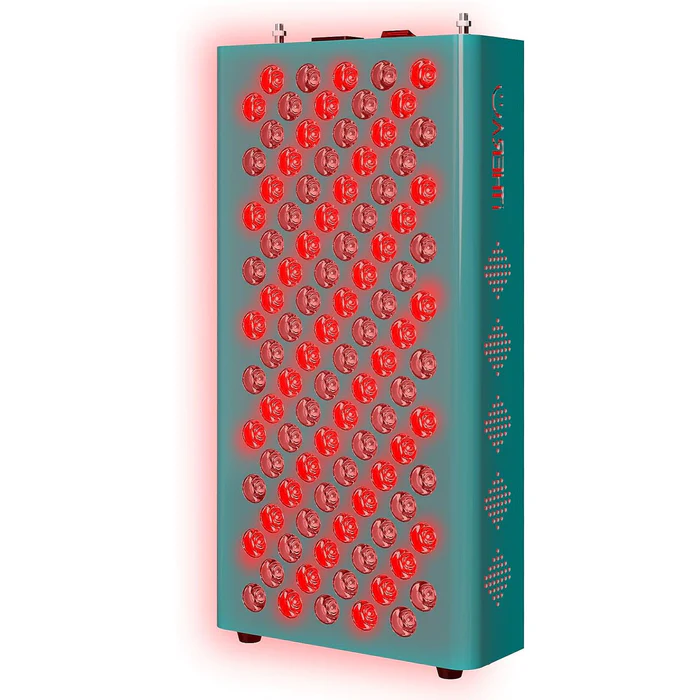For the past few months, I’ve been standing in front of a red light therapy lamp for about 5 minutes a day. We ordered the red light therapy system when my spouse was recovering a knee injury since it helps speed wound healing. Now, I’m loving it for its collagen boosting (*wrinkle reducing*), scar reducing, and hair growth benefits..

What Is Red Therapy Light?
Red light therapy is also known as photobiomodulation (PBM), low level light therapy (LLLT), biostimulation, photonic stimulation or light box therapy.
This therapy uses specific wavelengths of light to treat the skin to accomplish various outcomes. Studies have shown that different wavelengths affect the body in different ways. The most effective wavelengths of red light seem to be in the ranges of 630-670 and 810-880 (more on this below).
How Does Red Light Therapy Work?
These specific wavelengths of red light create a biochemical affect in our cells that serves to increase mitochondrial function. This improves ATP (adenosine triphosphate) production in the body.
Why is this important?
ATP is the source of energy for every cell in the body. Without it, we don’t function at all. Without enough of it, we don’t function well.
It’s wavelengths range between 630-880nm and are used to treat the skin’s surface. Red therapy light penetrates about 8-10 millimeters into the skin. Depending on which area of the body the red light is used, this can easily affect all skin layers, reaching into blood vessels, lymph pathways, nerves, and hair follicles.
Red Therapy Light vs. Sauna Therapy
Many people wonder if RLT is similar to sauna therapy or the benefits of sunlight.
All of these therapies are beneficial, but they are different and provide different results. I’ve been a big fan of sauna use for years, but I’ve also added red light therapy to my daily practice for different reasons. Check out my home oasis blog for my details.
The purpose of a sauna is to raise the temperature of the body. This can be accomplished through simple heat exposure by raising the temperature of the air, as is popular in Finland and other parts of Europe. It can also be accomplished through infrared exposure. This heats the body from the inside out in a sense and is said to provide more beneficial effects in less time and at lower heat.
Both sauna methods increase heart rate, perspiration, heat shock proteins and improve the body in other ways. Unlike red light therapy, infrared light from a sauna is invisible, and penetrates much deeper into the body with wavelengths at 700-1200 nanometers.
Red therapy light or photobiomodulation is not designed to increase perspiration or improve cardiovascular function. It impacts cells on the cellular level and increases mitochondrial function and ATP production. It essentially “feeds” your cells to increase energy.
Both have their uses, depending on the desired results.
The History of Red Therapy Light Use
Red light therapy has been around the block. In 1903 physician Niels Ryberg Finsen won the Nobel Prize in Medicine for his successful treatment of smallpox and lupus with red light. Russia uses low level laser therapy in their standard medical care (and they have since the 1970s). The Russians also published hundreds of studies over the decades on the benefits of red therapy light. Unfortunately, very few of these studies have been translated into English.
Red light therapy has largely been ignored by the US and western Europe until recently. However it’s been used in a clinical setting since the 1980s in Japan, China, Canada, Northern Ireland, Vietnam, Latin America, and Eastern Europe.
The Benefits of Red Therapy Light
Even though the western world is behind the times with red therapy light, strong evidence supports its health benefits. It is FDA approved for chronic joint pain, slow to heal wounds, wrinkles, hair loss and acne. Many others have used it successfully for other issues, like psoriasis, improved circulation and better immune function.
Here’s a partial list of the evidence-based uses of red therapy light:
- It helps rejuvenate facial skin and smooths skin tone.
- Red light builds collagen in the skin to reduce wrinkles.
- It helps to repair sun damage.
- Red light activates the lymphatic system for potentially improved detoxification.
- Decreases inflammation in the skin.
- Helps fade scars and stretch marks.
- Improves hair growth to reverse balding.
- Stimulates slow healing wounds.
- Beneficial for skin to reduce eczema, rosacea, and acne.
1. Better Circulation and Collagen Production
When the light penetrates through the epidermal and dermal skin layers, it increases circulation to help form new capillaries. It also increases collagen production and fibroblasts. While topically applied collagen is useless, I frequently consume it for the health of my nails, skin, hair, and joints. Red therapy light improves collagen levels naturally by triggering the body to produce more of its own. Since collagen comprises about 70% of the protein in our skin, it’s a big deal!
Increased collagen doesn’t just give the skin a wrinkle-free glow, but its ability to improve joint health makes it great for arthritis sufferers. It can be helpful for those with a variety of painful musculoskeletal issues. The increased circulation and anti-inflammatory effects that red therapy light provides also help reduce pain and heal the body.
2. Wound Healing with Red Light Therapy
Fibroblasts in our skin synthesize collagen, maintain connective tissue and are integral to wound healing. Red therapy light stimulates fibroblasts to do their job, and increases circulation for faster wound repair time. People have also used this therapy for burns, amputation injuries, skin grafts and infected wounds. It’s been successfully used for skin damage caused by cancer treatments, including those in the mouth and mucus membranes.
In a 2014 study, researchers found that red light therapy significantly improved colitis symptoms in mice. The light therapy aided in their mucosal healing. Dentists have also successfully used red therapy lights to heal sores and abrasions in the mucus membranes of the mouth. It’s also been found to prevent recurring cold sores that occur along the mouth.
3. A Remedy for Hair Loss
I have plenty of natural remedies on my site for how to improve hair growth, but red light therapy may be another way to reverse balding. A 24-week study demonstrated that red therapy light significantly improved hair density and hair thickness without any serious reactions. Participants wore a helmet that emitted red therapy light to achieve this effect, though I’ve found that bigger devices( 
4. Recover Faster from Injury and Illness
Red light therapy increases circulation and ATP production throughout the body which may help speed healing during times of illness. It also stimulates lymph system activity and phagocytosis, the process of cells cleaning house.
Although red therapy light helps to modulate the immune system, a 2006 study with mice found that over treatment actually resulted in immune suppression. Since not a lot of research has been done in this area, it’s unclear just how beneficial it is for the immune system.
5. Help for the Thyroid
One of the big reasons I started looking into red light therapy is because of the potential for improved thyroid function. There are several compelling studies that look at the benefits of red light and near infrared therapy for thyroid health. As someone who has struggled with Hashimoto’s Thyroiditis, I was interested in trying this kind of therapy.
One randomized, placebo-controlled clinical study from 2013 looked at the benefits of light therapy on chronic autoimmune thyroiditis. This study showed an overall improvement in thyroid health from near infrared and light therapy. Many participants were able to reduce or eliminate their thyroid medication. In fact, a startling 47 percent of the participants no longer needed medication during the entire nine-month follow-up after the light therapy treatment. This is shocking as most people are told that they will need thyroid medication for the rest of their lives.
When looking at Hashimoto’s (autoimmune thyroid problems) specifically, the study found a reduction in thyroid peroxidase (TPOAb) antibodies. These antibodies indicate the presence of an autoimmune thyroid condition.
Other studies have shown:
- a 2010 study from Russia found that red light therapy helped 38% of participants reduce thyroid medication dosage (17% stopped medication completely)
- A 2003 study on postsurgical thyroid patients found that red light therapy reduced the need for medication by up to 75%
I personally started researching this benefit after seeing doctors use this therapy for thyroid disease while visiting a natural medicine clinic in Switzerland. While I was there, they had me wear a red light therapy device on my neck to benefit my thyroid. I’ve been continuing this therapy at home with my red light.
6. A Promising Therapy for Psoriasis
A small scale study published in the journal of Photomedicine and Laser Surgery found benefits for psoriasis sufferers. Skin plaques improved by 60-100% when treated with both red therapy light and infrared light, like that used in a sauna. The infrared light helped to calm inflammation, while the shorter red wavelengths helped heal the skin’s surface.
Though I don’t have psoriasis, I’ve personally noticed skin benefits from using a combination light (I have the Joovv combo unit linked below) that combines near-infrared spectrums (810-880) and visible red spectrums (630-670).
7. Help for Acne, Rosacea, and Eczema
The collagen and ATP stimulating benefits of red light therapy make it a promising solution for skin problems like acne, rosacea, and eczema. Personally, the first benefits I noticed were in reducing stretch marks and wrinkles. Over time, I’ve also noticed new hair growth on my hairline.
How to Use a Red Therapy Light
Some spas, rheumatologists, and dermatologists offer red light therapy treatments. A doctor may also be able to give a referral to a trained professional. Since there are only a few FDA approved uses for red therapy light, treatment may not be covered by insurance in some cases.
There are also salons and spas that offer red light therapy. These options often range from $50-100 a session.
I’ve found that it is more convenient (and likely much cheaper) to get the benefits of red light therapy at home.
My Experience With Red Light Therapy
We originally purchased a Joovv when my husband had hernia surgery. Much of the research showed faster recovery and wound healing. He used the device twice a day during his recovery and healed faster than expected.
Most exciting for me is that it has also been helping my thyroid and I’m working to reduce my thyroid medication dosage over time.
Where to Buy a Red Light Therapy Device
There are plenty of at-home devices for sale from a variety of manufacturers. I wanted to find a device that used a combination of wavelengths for maximum benefit. This way, I would get the benefit of the deeper penetration of the higher wavelength and the cellular “charging” of the lower visible spectrum.
Cautions & Considerations
As with any device, this isn’t the best fit for everyone. Some light therapy devices pulse or flash the light during treatment, which may be an issue for those with a history of seizures. I see no benefit to the pulsing and would avoid these devices. There are red therapy light devices that don’t pulsate.
Studies indicate that red light therapy is safe during pregnancy. I still recommend checking with a doctor or midwife to ensure that it is safe for you.
While red light is considered safe for the eyes, some people find it too bright. Simple tanning glasses make red light therapy more comfortable.
Red Light Therapy FAQs
A few other questions I had when I started researching red light therapy:
Is it safe?
Yes. Red light therapy is an FDA approved therapy and considered safe. In fact, the original research for modern red light therapy came from NASA. Red light devices were used to limit bone and muscle loss in space. They also discovered that certain spectrums of red light allowed plant growth (for food) in space.
Does it get hot? Can you tan with it?
No and no. It gets pleasantly warm but not hot. Red light is a different wavelength than UV light. It does not produce any tanning effect.
Have you ever used red therapy light, or are you interested in trying it?
